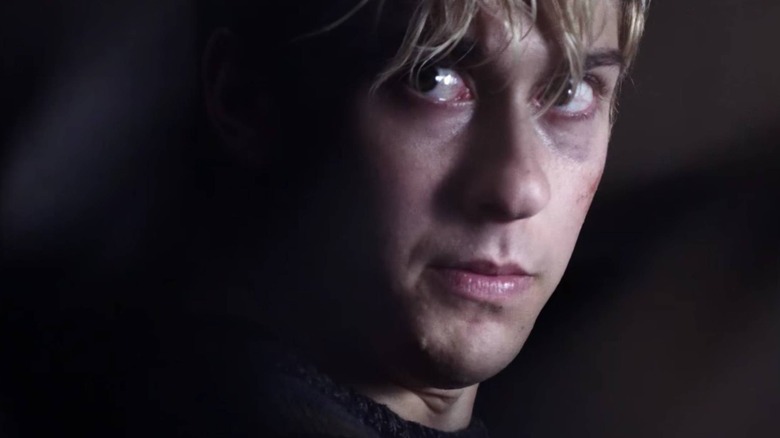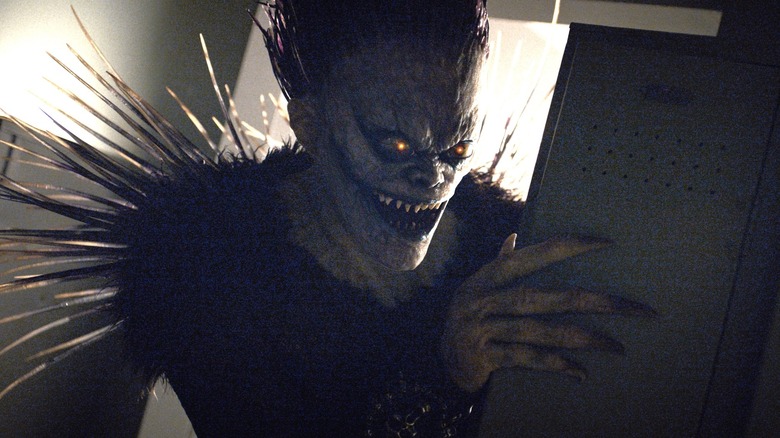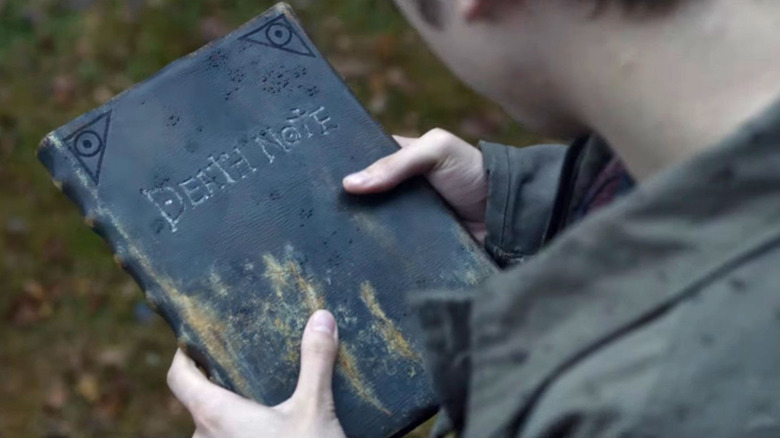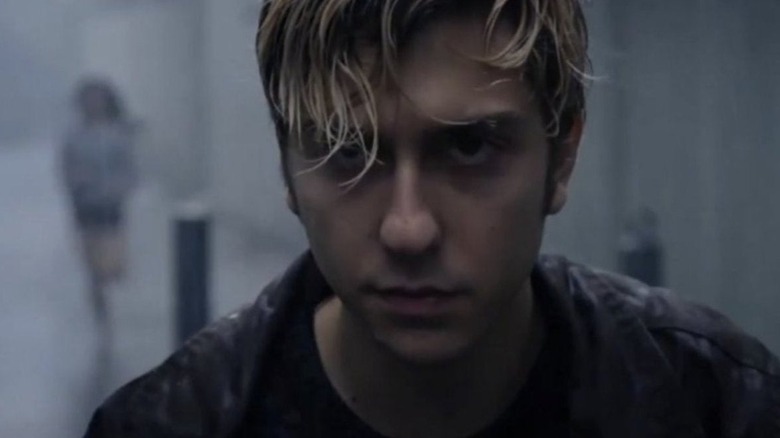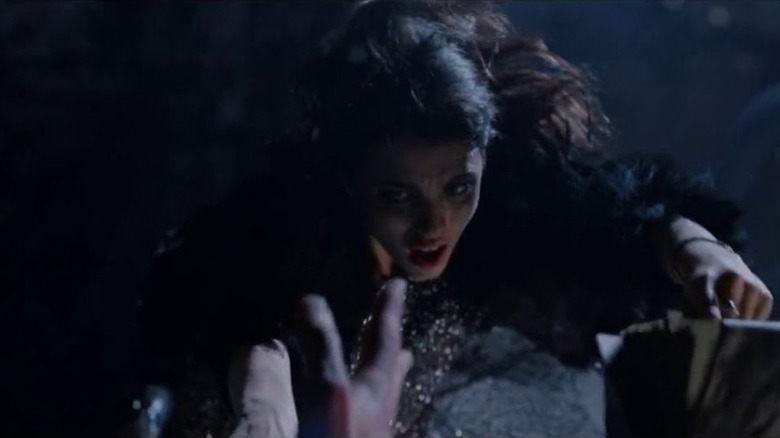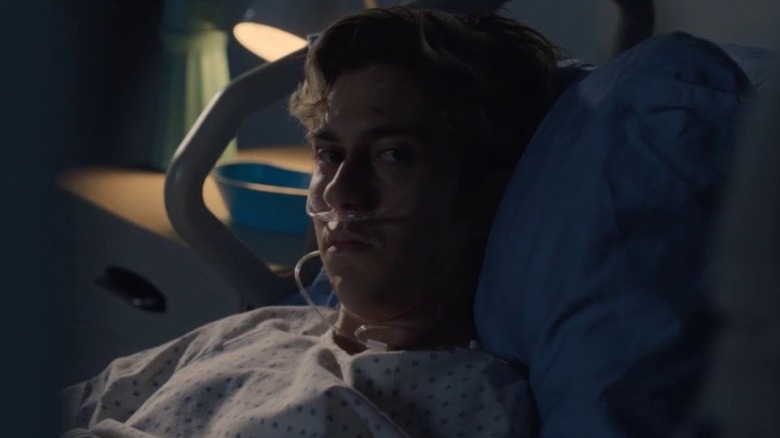The Ending Of Netflix's Death Note Movie Explained
Directed by Adam Wingard, Netflix's 2017 movie "Death Note" caused quite a negative stir when it was first released. The original property was based on the Japanese manga series written by Tsugumi Ohba with illustrations by Takeshi Obata. "Death Note" was also turned into a more successful 2006 anime series that was extremely faithful to its source material, unlike the dreadful fate of the overtly Americanized film version that Wingard helmed.
Set in Seattle, "Death Note" stars Nat Wolff as teenage loner Light Turner and Margaret Qualley as the popular cheerleader, Mia Sutton, who desires full control over the notebook, and with whom Light forms a strange (and rather quick) bond. The film follows Light as he discovers a mysterious notebook that falls out of the sky titled "Death Note," a book that possesses supernatural powers in that any name that the owner of the book writes down while imagining the person's face in their head, dies in whatever way that they wish.
In an adaptation that strays quite far from the manga, there are many inconsistencies and changes that didn't work at all. From Light reading the Death Note out loud in public to showing it to Mia the moment he talks to her, there are too many problems present from the very beginning. So why didn't the movie succeed? And what was up with that ending?
Ryuk barely appears in the film
One of the most fascinating characters in the manga is Ryuk, a bored Shinigami creature who desires to wreak havoc in the human world. Less than intrigued with his own realm, Ryuk drops the bloodthirsty "Death Note" notebook from the sky to see which poor mortal soul (which happens to be Light) would take it and becomes its owner.
Just as in the manga, Ryuk can only be seen by the owner of the notebook. He functions as sort of a sinister teacher to Light, explaining to him the rules of the book and eagerly waiting to see what dumb decisions Light and the other characters make (spoiler: there's a lot of them). In the film adaptation of "Death Note," the Shinigami is voiced by our favorite resident bad guy Willem Dafoe.
Speaking to IGN, Dafoe shared that he didn't find it necessary to read the source material and made Ryuk entirely his own creation. Unfortunately, we didn't see enough of the character in the film, which clearly was a decision made by Wingard and the screenwriters. Perhaps it would have been better for Light's wisecracking tormentor to have more a substantial role in the overall story and show more of what he mischievously does behind the scenes. Ryuk has a more gratifying presence in both the manga and anime series.
The characters don't even follow the rules of the Death Note
Another frustrating aspect of "Death Note" is that the characters blatantly ignore the rules, or have little to no knowledge of how the notebook works. Light and Mia (named Misa in the manga) don't follow the rules set in the notebook, and Light chooses not to listen to Ryuk when he tells him that he can easily give the Death Note to another person so that he can be relieved of all the strife it's causing him.
Light and Mia create a made-up entity named Kira (meaning "killer" in English) to take the blame for the mass killings of criminals happening around the world. Ironically, these two completely mishandle the strict rules bound in the book and don't consider one of the most important rules in the Death Note: only the owner can write names in the notebook. Well, that goes completely out the window when the power-hungry, psychopathic Mia covertly steals the notebook from Light and ends up writing his name down in the book.
L (played by Lakeith Stanfield) is a peculiar detective who has an obsession with candy and is another character who could be seen as insufficiently fleshed out. He's hired by the government to track down who is responsible for the deaths outlined in the notebook. Stanfield asserted in an interview with Bustle that the film is a re-envisioning of the source material. While it has the same characters, the film does diverge from the manga in terms of the broader plot elements, sticking more closely to its basic points.
The deaths are more gruesome in the film
In the manga, people often die from a heart attack after having their name written down in the Death Note. However, Wingard's film opts for "Final Destination"-style, over-the-top, brutal kills, from having one of Light's bullies get decapitated after a ladder slices his head off, to having a gratuitous slaughter-fest in a Japanese nightclub. In a typical Westernized way, Wingard opts for style over substance and relies on empty shock value to appeal to the audience.
In the anime, Light handles the deaths with more abrupt precision and less of an emphasis on the details of the kills. In fact, the anime isn't at all interested in showing these disgustingly bloody murders as the American version does. Light's god complex becomes evidently clear in both versions but feels even more horrifying in the ways he chooses to kill his victims in the movie.
The end does not justify the means
There is an intensely comical chase scene toward the end of the film featuring the police, L, and Light, with Light's father, James (Shea Whigham), a police detective tasked to aid in solving the Kira case, following them. The entire sequence feels clumsy and tacked on without any real purpose, and it only leads to Light and Mia on top of a Ferris wheel fighting over the notebook. Light discovers Mia's true intentions the entire time that they were together — getting close to him so that she can gain total control over the Death Note. Not only is the acting arguably subpar but it's also difficult to care about characters that are selfish and make choices that end up only benefiting themselves. Also, how could Light's father be so clueless as to not figuring out that Kira was his son the entire time?
After the argument between Light and Mia, she falls from the Ferris wheel, plummeting to her death. Light also falls into the water below as the Ferris wheel collapses. Light is rescued and taken to the hospital where he explains to his father why he wrote names in the Death Note, hoping to rid the world of evil. It was more complicated than that, clearly. Ryuk suddenly appears in the hospital room; laughing maniacally, he says, "You humans are so interesting."
How the film's ending differed from the manga's ending
Indeed, humans are interesting and that's one of the perplexing facets of "Death Note," even though the entire movie adaptation felt silly and forced to many. The overarching theme of justice, which is essential to the story of both the manga and anime series, is tossed aside in the film and there's zero reflection on morality by the end credits. It can be argued that Wingard's adaptation doesn't work well as a supernatural, gory thriller, considering that most of the dialogue was laughable and not believable. "Death Note" would have worked better as a live-action television series, a standalone piece of work, or a devoted rendering of the Japanese source material.
By the film's end, when L finds a page from the notebook in Light's room, he laughs while writing down a name (which is alluded to that it could be Light), without any idea about the rules or how they work. While this ending hints at L writing Light's name down in the Death Note, in the manga, it is the ruthless Ryuk who puts Light's name in the notebook, killing him in a warehouse in front of the Task Force organization that has been searching for Kira. The closing of the film signifies that there could be a sequel (via ComicBook.com), considering that Light is still shown to be alive by its finale, but we're not getting our hopes up that it will be any better.
